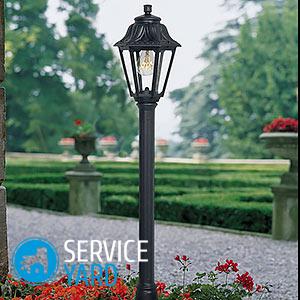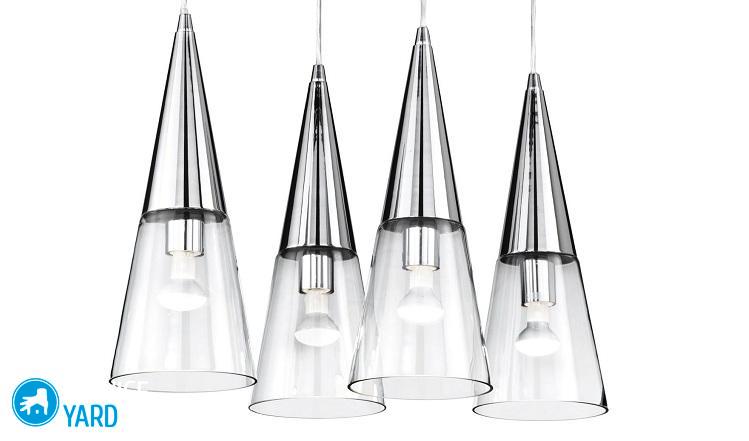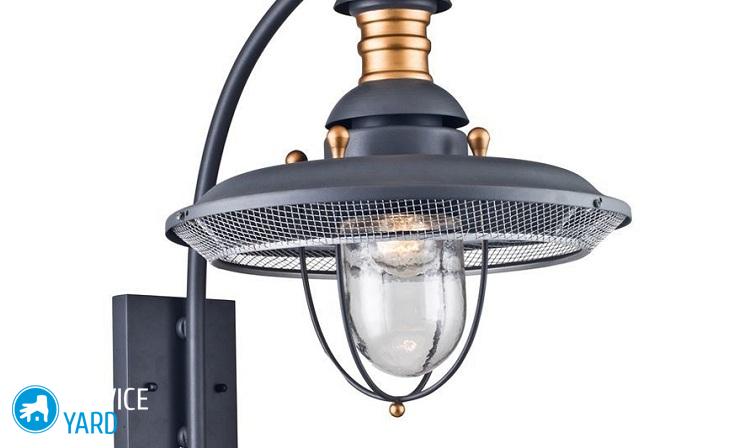Installation of street lighting

Installation of street lighting is one of the main factors of safety and comfort in your own yard. In addition, with the help of special street lamps, you can ennoble your site, using them as an element of design. The modern market offers a lot of different options for lighting, which, if desired, can be combined. Placement also depends purely on the wishes of the owner. It can be both pillars, arches, fences, and the earth. In this article you will find all the necessary information about this type of lighting, its types, options and rules for self-installation of a street lamp.
to contents ↑Important! It should be understood that the combination, the backlight system, as well as the high-altitude installation, need the help of a specialist.
Types of street lights
Faced with the choice of a lamp for the street, the owner of the site is often lost in a variety of light lamps. Which is better to choose? Which will cost less as a result? Which will last longer? Which ones will look prettier? And this is only the beginning of a large list of questions that arise in the head of the buyer.
Consider the main types of street lamps and their features in order to clarify a small part of these issues.
Incandescent lamps
A similar option is familiar to everyone, and what a centuries-old invention is, the majority knows. Let us dwell on its main features:
- Today it is an outdated option for street lighting, since it is not economical in comparison with more modern devices.
Important! The well-known “Ilyich’s bulb” consumes electricity many times more than its modern counterparts.
- It is a sealed flask filled with an inert gas with a filament. To prolong the operation of such a lamp, halogen vapor is added to the flask. These are the so-called halogen lamps.
- “Halogens” are very common in lighting such as lights and spotlights. They are quite effective and convenient, since they serve for a long time and the light delivers high-quality.
- Such lamps with halogen vapor filling are not recommended for use indoors because of their noisy performance. Also, if the bulb is damaged, vapors are leaked, which can lead to poisoning.
Important! Such lamps when lighting on the street are quite safe.
Mercury lamps
We are also familiar with these lamps - these are street lamps, which, when dark, automatically lit on the streets of our childhood:
- Such luminaires are controlled through a special starting device, and the switching speed depends on the ambient air temperature.
Important! In the cold season, the lamp ignition process takes longer.
- Mercury lamps are very sensitive to voltage surges, and in the case of such can go out.
- The connection of such lamps requires the use of special wires that are resistant to temperatures, since they are very heated during their operation.
Important! Such lighting is used, as a rule, for large areas. Profitability indicators contribute to this.
Metal halogen lamps:
- The composition of such lamps includes inert gas, mercury and halogens. When heated, these substances turn into steam, which emits light.
- The characteristics of such lighting are quite high. The lamp power is determined by the number of socles.
Fluorescent lamps:
- This lighting is the most economical option in terms of energy consumption.
- A feature of the lamp is a special phosphor coating that converts ultraviolet radiation into visible light.
Solar panels:
- Such a fixture is an excellent option for lighting the yard. Their food comes in the daytime from the sun.
- Due to the fact that such lamps do not require connection to the electric network, they can be placed in the yard anywhere and moved if necessary.
- It is absolutely environmentally friendly and quite practical street lighting.
- With their help, you can designally complement the site.
to contents ↑Important! Most often, solar-powered lamps are used in landscape areas.
Street lamp installation
If you opted for a non-solar battery, the installation of street lighting will require some knowledge and preparation:
- First of all, you need to understand in detail the connection scheme of street lamps. One of the main components of the circuit is a relay. This is a device that regulates the operation of an electrical circuit. Using it, you can set the necessary lighting parameters and the period of its operation.
- Also, relays can play the role of sensors that respond to changes in external factors, and, if necessary, start the process of connecting contacts.
Important! Vivid examples of such a device are photorelay, responsive to lighting, acoustic, responsive to appropriate sounds, thermal, which turns on when the ambient air temperature decreases or rises.
Relay connection diagram
Let us dwell in more detail on connecting a photo relay, since it is the most optimal option for street lighting:
- The maximum load on the device is from 1000 to 2300 watts.
Important! Relays should only be bought by trusted manufacturers. Be sure to pay attention to the degree of protection against external influences (IP44).
- Before starting installation, you must carefully read the instructions. Pay attention to the designation of the various wiring.
Important! The colors of wires in products of different manufacturers may vary, so you need to focus purely on the instructions for your relay.
- Each wiring has its own purpose: it is connected to the phase, zero, to the lamp. Such connections are best made through a specially designed junction box. It is convenient to fix all the wiring in it.
- Two contacts come out of the lamp: load switching (interruption and switching on of phase voltage) and zero. From the relay - three contacts: phase, zero (connects to the corresponding lamp wire), switching (goes to the lamp).
- Phase and zero exit the junction box.
As you can see, the connection scheme for street lamps is quite simple for self-installation. The most important thing is to carefully deal with the wiring.
to contents ↑Technological features of street lighting installation
The technology for installing street lighting is quite voluminous and includes many points:
- If the work is large-scale, then you need to draw up a project. The project must necessarily indicate the number and type of lights used, location, distance between them, type of relay, and so on.
- The choice of lighting lamps and the location of the cable (outside or underground), the fixing method (bracket, pole).
- The next stage of work will be soil preparation in the literal sense. It is necessary to dig a place for the cable and pole, lay the power cord.
Important! Be sure to mark the passage of the cord, so that in case of any work on the site does not damage it.
- Connect the cord to the flashlight.
Important! Be sure to pay attention to the installation location of the relay.If this is a photo relay, then it should be located in a well-lit place, otherwise - its functionality will be impaired.
- Poles and brackets must be earthed. This nuance of work is one of the most important safety factors.
Important! Grounding is the connection of the mains to a grounding device that goes into the ground. In the event of an emergency, the system reduces amperage.
- The last stage of installing a street lamp is to examine the entire system for insulation, phase-zero resistance.
Important! The phase-zero resistance is determined using a special device - a volt-ampere phase meter.
- After checking the system, you can turn on the network.
Basic safety rules for the installation of street lighting:
- The manufacturer of all the components necessary for installing a street lamp, you need to choose a proven and high-quality.
Important! Cheap Chinese products, although they save the budget initially, but often go defective, with broken insulation, which threatens a fire hazard. Lamps made of low-quality materials quickly burn out and break easily.
- To protect the lighting system from burnout, purchase a voltage stabilizer.
- Lamps need to be bought special - designed for street lighting. They are made of more durable materials and are weather resistant.
- Worry about the quality of insulation. This will extend the life of your device.
- Poles and brackets must be selected with a protective coating that protects the product from corrosion.
- Underground wiring must be placed at the correct distance from important objects:
- 60 cm from the house;
- 20-50 cm from another cable;
- More than a meter from gas pipelines and oil pipelines.
- A support cable must accompany it along the entire length of the cable.
Useful recommendations from specialists:
- It is better to choose a wire made of copper. With a voltage of up to 3 kW, the cross section should be from 3x1.5 mm.
Important! For greater electricity consumption, you need to choose a larger wire cross section.
- If you lay the cord underground, use pipes. They will provide additional protection.
Stock footage
Electricity requires careful handling. Therefore, when installing street lighting, it is required to study all the nuances of a phased operation and observe safety. In order not to forget anything important, make an action plan. Having done everything right, you can enjoy high-quality and beautiful lighting of the site in the dark.
- How to choose a vacuum cleaner taking into account the characteristics of the house and coatings?
- What to look for when choosing a water delivery
- How to quickly create comfort at home - tips for housewives
- How to choose the perfect TV - useful tips
- What to look for when choosing blinds
- What should be running shoes?
- What useful things can you buy in a hardware store
- Iphone 11 pro max review
- Than iPhone is better than Android smartphones





